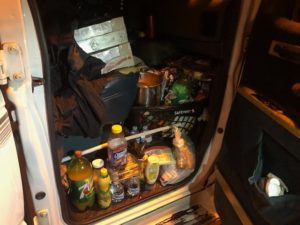Joe Castro has been homeless on and off his entire life. Now, Castro, his wife, Donna Slaughter, and their three children are living inside a cramped van, using the backseat to sleep five people and the front seat as a “kitchen” while they get back on their feet.
“It’s hard because our kids go to school on the east side, but we’re way out here because this is the only place we could find that’s safe parking,” Castro, 55, said. “There’s security here and we haven’t seen anything bad around here.”


Castro and his family park their van overnight in a taped off lot through San Jose’s new safe parking program at Seven Trees Community Center. The backseat, where the couple and their three kids sleep, is overflowing with blankets and pillows. They have to cramp their legs and squeeze into corners to fit in.
The couple is aggressively looking for jobs to get back on their feet. While walking through the mall recently, Slaughter laid on a bed on display inside a JC Penny store. She stretched her legs and let them dangle over the bed — and didn’t want to get up.
“I want to be able to sleep on a regular bed,” Slaughter said. “I want to be able to stand in front of the stove and cook my family a meal.”
Right now, she “cooks” her family a meal in the passenger side of the van — her kitchen — which is stocked with Cup Noodles, soda, hot sauce, crackers and bottled water. She buys food from the deli and adds crab meat and lemon juice.
“Tonight I wanted a Mexican dish,” she smiled. “Shrimp ceviche. And we have crab, shrimp.”
Safe parking begins in San Jose
The San Jose City Council in October approved the $250,000 program that allows up to 17 families living in their cars to sleep a little more sound at night. The nonprofit Life Moves, which serves homeless individuals and families, has run the day-to-day operation since November and provides security and case management to help families move into shelters or more stable housing.
“It’s a model that we are adopting from our shelter program,” Program Director Marc Sabin said about the case management portion of the program. “We’re adapting that for families living in their vehicles for whatever reason and they haven’t made it into shelters. It’s the way to expand the number of families that we can work with toward getting them into stable housing.”
Castro and Slaughter are hoping that Life Moves can help put a roof over their heads. They started living in a 1996 van after Slaughter and their children, ages 7, 12 and 13 stopped living with family. She said it became too crowded and people were drinking and smoking marijuana at the house – something the sober couple didn’t want to be around.
Since November, Life Moves has transitioned nine families from cars and into more stable shelter. With metrics like those, the city is looking toward expanding the program to two more lots and offering services to those without children, as well.
“We have some funding from the state coming, called the homeless emergency aid program,” said Ragan Henninger, a deputy director in the Housing Department. “We’re going to use some of that money to expand our pilot and we are looking at Roosevelt Community Center and South Side Community Center.”
The San Jose Planning Commission on Wednesday approved a policy to allow safe parking in lots at churches, schools and nonprofits. According to Henninger, it was modeled after the city’s shelter ordinance. The commission recommended giving people three extra hours to leave the lot — by 10 a.m. — and removing a ban on cooking or preparing food outside their vehicles. The ordinance is slated to be heard by the City Council in a few weeks.
Safe parking in other cities
While a city-sanctioned safe parking program is new for San Jose, it’s certainly not a new concept.
Sabin said Life Moves’ staff visited Santa Barbara’s Safe Parking Shelter and Rapid Rehousing Program – a gold standard for safe parking that has garnered national headlines – to learn more from the parking pros. The program has been in operation since 2004 and manages 134 spaces, according to the organization’s website.
Closer to home, the Santa Clara County Board of Supervisors last June allocated $287,525 for a safe parking location at St. Timothy’s Episcopal Church in Mountain View.
But District 5 Supervisor Joe Simitian – whose district spans from parts of West San Jose to Palo Alto – said they’ve run into a problem. While the site has been operational for some time now, it can only accommodate four cars due to land use laws. That’s a lot of work for very few people, he says.
“Different communities that want to be helpful are going to run into these land-use permitting issues,” Simitian said. “Even if you go to 10 different organizations, then you’re at 40 (spots). How do you scale this up so that we’re really making a difference?”
Simitian wants the board to create a model ordinance for safe parking that smaller Bay Area cities can adopt without draining their own resources.
Negative impacts from safe parking?
Back inside the van, Castro said he supports extending the program to other community center lots, but he hopes that it won’t mimic some of San Jose’s homeless encampments.


“Are people going to be using there and getting high?” he asked. “I feel like that’s a huge factor. I told (my wife) the other day when we’re passing these tents and you see all the trash, that’s why it’s a big problem — because it’s a mess.”
For residents worried about safe parking programs creating a “mess” in their neighborhoods, Sabin said the results at Seven Trees have been far from negative.
“Someone who is engaged with the Seven Trees Community Center said she’s getting reports from neighbors that since we began running services the neighborhood is much safer,” he said. “So anecdotally there’s success from the client perspective and from the neighborhoods. It’s an add to the neighborhood, not a detraction.”
And while the decision to add two more sites is pending, Sabin hopes word of mouth travels about the services they’re already offering. The current site, which is only open to those with kids, has yet to meet capacity.
“The homeless crisis is a crisis,” Sabin said. “And without being able to magically build housing or magically build more shelter space, there has to be creative solutions.”
Contact Grace Hase at [email protected] or follow her @grace_hase on Twitter.



Leave a Reply
You must be logged in to post a comment.